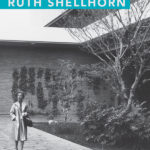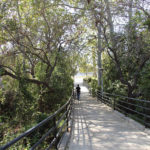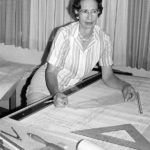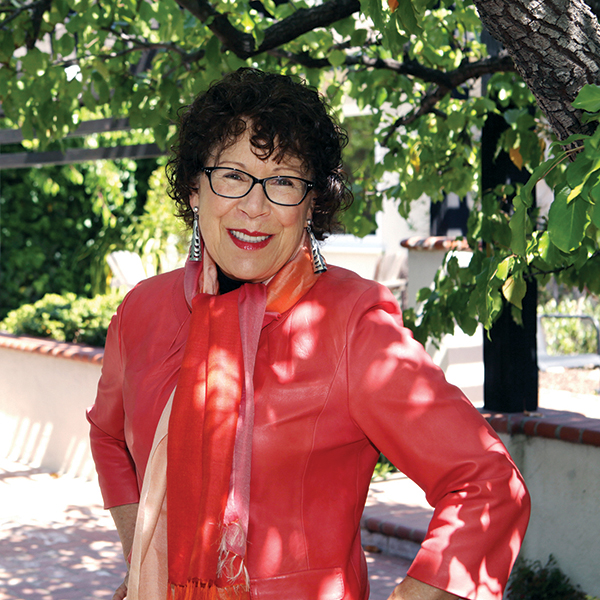By LIBBY MOTIKA
Palisades News Contributor
 A landscape architect who espouses simplicity and promotes the use of native plants and sustainable landscapes would most certainly find a sympathetic philosophy in the landscape business today.
A landscape architect who espouses simplicity and promotes the use of native plants and sustainable landscapes would most certainly find a sympathetic philosophy in the landscape business today.
Yet Ruth Shellhorn was promoting these ideas throughout a career that spanned six decades from the late 1930s to the late 1980s and included nearly 400 landscape designs.
While few of her gardens remain—the art is ephemeral; plants grow old and die—her ideas about the importance of topography, incorporating nature in an urban setting and creating surprise and interest in a landscape are still important precepts.
Shellhorn’s designs for the Bullock’s department stores reimagined these campuses not just as shopping depots but as destinations, oases from the noise and hassle of the city.
In thinking about the new UC Riverside campus, she resisted leveling the area, and instead incorporated the site’s canyons and arroyos into the scheme, providing bridges and winding paths.
Her core landscape designs for Disneyland remain to this day the skeleton design at the Anaheim park.
Palisadian Kelly Comras, a landscape architect, will survey Shellhorn’s career and her extraordinary achievements by presenting a short documentary and lecture based on her book, Ruth Shellhorn (University of Georgia Press) for Pacific Palisades Historical Society members and guests on Monday, May 23, from 7 to 9 p.m. at Pierson Playhouse, 941 Temescal Canyon Rd. The event is free to the public.
One is tempted to dwell on gender when considering the career of a woman in a predominantly male profession. In the case of Shellhorn, the obstacles became a measure of her tenacity.
 Not only did she choose a field dominated by men, but embarked on her career during the Depression, when she experienced prejudice in finding jobs because of the belief that men who supported families should have priority.
Not only did she choose a field dominated by men, but embarked on her career during the Depression, when she experienced prejudice in finding jobs because of the belief that men who supported families should have priority.
A clue to Shellhorn’s certainty about what she wanted to do in life is a simple conversation she had with her South Pasadena neighbor, the landscape architect Florence Yoch (who concentrated on estates for the wealthy and designed sets for such motion pictures as Romeo and Juliet and Gone with the Wind).
Hardly encouraging, Yoch told the then 15-year-old Shellhorn that the academic preparation was rigorous and that the practice would entail hard work, not simply pure pleasure.
Shellhorn took the discouragement as a challenge and was determined to show Yoch that she had what it took to be a landscape architect.
A bright student, Shellhorn enrolled in the School of Landscape Architecture at Oregon State Agricultural College, where she achieved the highest marks in the school and earned a prize in a Beaux-Arts design competition.
in a Beaux-Arts design competition.
Before her senior year in 1930, she transferred to Cornell University to secure a surer foundation in architecture. Her parents, who had always encouraged their only child, sold their house in order to pay her tuition. But by 1933, just four units shy of graduation, Shellhorn was unable to afford the tuition and had to leave Cornell without a degree.
Her subsequent route towards establishing her career was circuitous but provided Shellhorn invaluable observations on the natural world, architecture and garden design. Before returning to Southern California, she traveled for three weeks on a mail steamer through the Caribbean and Central America.
A prodigious diarist, Shellhorn took notes on design, landscape materials, plant descriptions and even details on the construction and operation of the Panama Canal.
When Shellhorn returned to Los Angeles in the summer of 1933, she faced bleak employment prospects. But she counted on her excellent and elite education (most practitioners had come up through apprenticeships at nurseries) and her unstinting belief in herself.
“I think a lot of it’s in your own attitude,” she later told Comras. “If you go at it as a person, you’re not a woman or a man. It doesn’t make any difference. You have a problem to solve. So you cooperate and you work on that problem.”
With little prospects of joining an established firm, Shellhorn instead sought out practitioners, expanding her contacts and slowly building a small residential practice.
She eventually ran a practice with her husband Harry Kueser, whom she married in 1940. Throughout the late 1930s, she worked hard to find opportunities to display her work, writing articles for such magazines as House and Garden and Sunset.
Ironically, Shellhorn found her first large-scale project during the lean years of World War II. In 1943, she began a design for a shoreline development study commissioned by L.A. County. Underwritten by a group of businessmen, the plan included park designs for Manhattan Beach, Torrance and a regional park for Redondo Beach and Hermosa.
The Shoreline Development Study became a blueprint for later management of the coast, defining restrictions on oil drilling, sewage treatment and public funding for park acquisition, Comras says. “It lay the foundation for the California Coastal Act of 1976.”
The plan also spelled a turning point in Shellhorn’s career, helping her gain her biggest commission: designing a site plan for Bullock’s Pasadena, the first suburban store in the region and one of the first to accommodate the automobile.
In designing the Bullock’s campus, Shellhorn emphasized the pleasure of the whole experience. Not only did she create a pleasing environment for shopping, she also provided settings where shoppers (and their patient husbands) could sit and relax.
She screened unsightly views and turned mundane passages into possibilities for a scene. She was especially attentive to detail, and created focal points, such as an espaliered vine covering an otherwise unadorned wall, or placing especially sculptural trees for dramatic emphasis.
“Shellhorn’s Bullock’s Pasadena set the standard for the shopping mall of future generations,” Comras says. “In the process, her Bullock’s designs became icons of the Southern California landscape.”
Bullock’s Pasadena also brought Shellhorn and Welton Becket together in the first of many collaborations. The architect, who was already well known in Los Angeles, first met Shellhorn in 1945 and immediately shared the idea of “total design,” which assigned one firm to manage an entire project, from design and engineering to interiors and landscape.
Shellhorn emphasized the importance of working out the landscape scheme from the beginning of the project. “Problems are better solved,” she said.
Shellhorn’s collaboration with Becket grew as the architect relied on her unreservedly. In 1955, in fact, he recommended her to his friend Walt Disney, who just four months before Disneyland was to open was struggling to unify the different sections of the park.
How do you link tropical Adventureland to dusty, dry Frontierland and into the future in Tomorrowland, while making Fantasyland fairylike? That was just one of Shellhorn’s challenges. She also designed a circulation path through the park, plus the landscaping for the Town Square, Plaza Hub and Main Street.
Shellhorn and her team worked seven days a week; she even grabbed a shovel and helped dig the moat around Sleeping Beauty’s Castle—in a skirt.
Comras first became aware of Ruth Shellhorn while a graduate student in landscape architecture at Cal Poly Pomona. For an assignment to profile a Fellow of the American Society of Landscape Architects, she picked Shellhorn, because she was the sole woman member.
Thirty years later she decided to revisit Shellhorn as a subject for an online writing course.
“The first assignment was to choose from a list of 50 things you’d like to write about, so I looked up her number, and she was still there in her home in Redondo Beach. I went out there, we immediately hit it off and she took me to her back room, which was her studio. By that time, she was retired, had no heirs and the estate was in a trust.”
Comras was worried that Shellhorn’s legacy was in danger of being tossed, and knew that her dream was to have her material easily accessible to the public. Although the Huntington Library and USC were interested in the archive, UCLA was the better repository because of its open policy on access.
The two women worked to organize Shellhorn’s 400 boxes of material covering a 60-year career. In 2011, the archive was opened to the public.
Shellhorn died in 2006, but not before receiving two degrees from Cornell 72 years later, one for architecture and one in landscape architecture.
Ruth Shellhorn in her studio in Redondo Beach, 1967. Photo courtesy of Kelly Comras
Bridges over the arroyos of University of California, Riverside allowed preservation of the natural features that Shellhorn called “rivers of green.” Photographed by Ruth Taylor Kilday, 2011
Ruth Shellhorn and Walt Disney at Disneyland Western train station on July 2, 1955, two weeks before opening day. Photographed by Harry Kueser, courtesy of Kelly Comras
Kelly Comras. Photo: Bart Bartholomew












You must be logged in to post a comment.